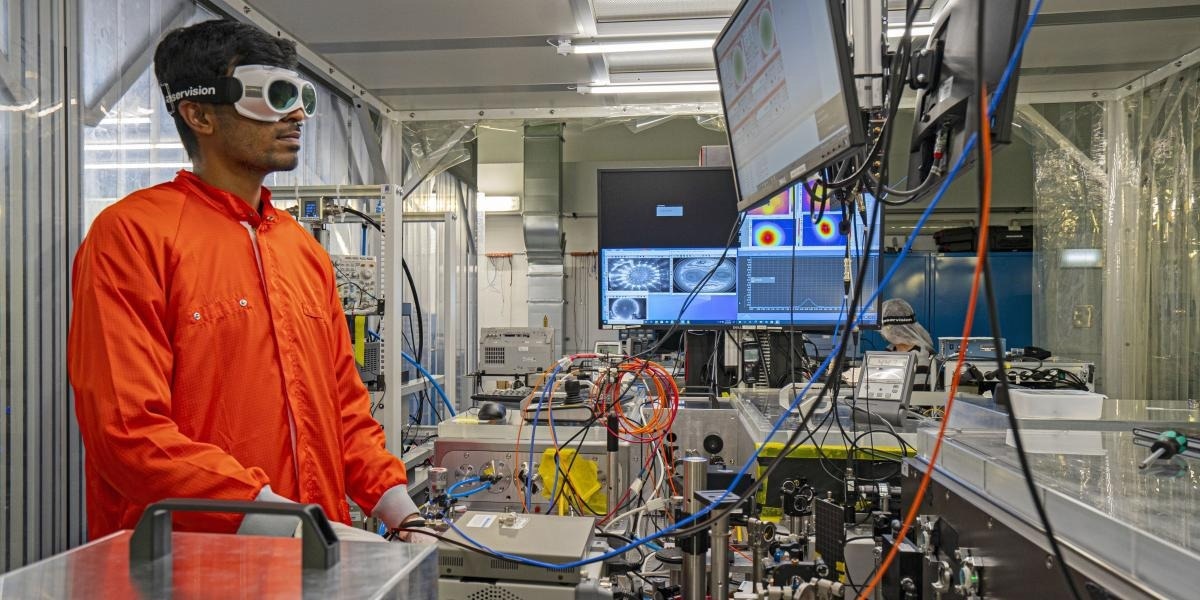When light passes through molecules, it is captured and re-discharged. Modern developments in ultrafast laser technology have progressively enhanced the depth of details in studies covering light-matter interactions.

Oscillation of a light field: In the laboratory of LMU physicist Ioachim Pupeza, his colleague Philip Jacob measures the light field of a molecule using time-resolved spectroscopy. Image Credit: © Thorsten Naeser.
FRS, a laser spectroscopy technique wherein the electric field of laser pulses repeating millions of times per second is documented with time resolution after moving via the sample, offers even better insights.
Researchers guided by Prof. Dr. Regina de Vivie-Riedle [Ludwig Maximilian University (LMU)/Department of Chemistry) and PD Dr Ioachim Pupeza (LMU/Department of Physics, The Max-Planck-Institute for Quantum Optics (MPQ)] demonstrate for the first time in theory and experiment the way molecules slowly absorb the energy of the ultrashort light pulse in each independent optical cycle, and then discharge it once more over an extended period, thereby transforming it into spectroscopically significant light.
The study explains the mechanisms that primarily establish this energy transfer. It also advances and validates a comprehensive quantum chemical model that can be employed going forward to quantitatively estimate even the least deviations from linear behavior.
A child on a swing causes the swing to move with tilting actions of the body, which must be coordinated with the movement of the swing. This slowly contributes energy to the swing, so that the swing’s deflection increases over time.
To some degree a similar occurrence takes place when the alternating electromagnetic field of a short laser pulse passes through a molecule, approximately 100 trillion times faster: when the alternating field is coordinated with the vibrations between the atoms of the molecule, these vibration modes capture more energy from the light pulse, and the amplitude of the vibration expands.
Once the exciting field oscillations are finished, the molecule remains vibrating for some time—similar to a swing after the child stops the tilting actions.
Similar to an antenna, the marginally electrically charged atoms in motion then emit a light field. Now, the frequency of the light field oscillation is established by the properties of the molecule such as bond strengths and atomic masses, which facilitates the identification of the molecule.
Scientists from the attoworld team at LMU and MPQ, in partnership with LMU scientists from the Department of Chemistry (Division of Theoretical Femtochemistry), have currently differentiated these two integral parts of the light field—the exciting light pulses and the decaying light field oscillations—using time-resolved spectroscopy.
Subsequently, they examined the actions of organic molecules dissolved in water.
While established laser spectroscopy methods usually only measure the spectrum and thus do not allow any information about the temporal distribution of the energy, our method can precisely track how the molecule absorbs a little more energy with each subsequent oscillation of the light field.
PD Dr Ioachim Pupeza, Head, Experiment, Ludwig Maximilian University of Munich
That the measurement technique enables this temporal difference is best demonstrated by the fact that the researchers conducted the experiment again, altering the length of the exciting pulse but without altering its spectrum.
This renders a huge difference in the dynamic energy transfer between light and the vibrating molecule: Subject to the temporal structure of the laser pulse, the molecule can then capture and discharge energy many times during the excitation.
A Supercomputer-Based Quantum Chemical Model
To comprehend precisely which contributions are pivotal for energy transfer, the scientists have designed a supercomputer-based quantum chemical model. This can elucidate the outcomes of the measurements without the assistance of measured values.
This allows us to artificially switch off individual effects such as the collisions of the vibrating molecules with their environment, or even the dielectric properties of the environment, and thus elucidate their influence on the energy transfer.
Martin Peschel, Study First Author, Ludwig Maximilian University of Munich
Eventually, the energy re-discharged during the decaying light field oscillations is pivotal for how much data can be attained from a spectroscopic measurement.
The study, therefore, makes a significant contribution to an enhanced understanding of the efficiency of optical spectroscopies, for instance, concerning molecular compositions of gases or fluids, to improve it more.
Journal Reference:
Peschel, M. T., et al. (2022) Sub-optical-cycle light-matter energy transfer in molecular vibrational spectroscopy. Nature communications. doi.org/10.1038/s41467-022-33477-5.